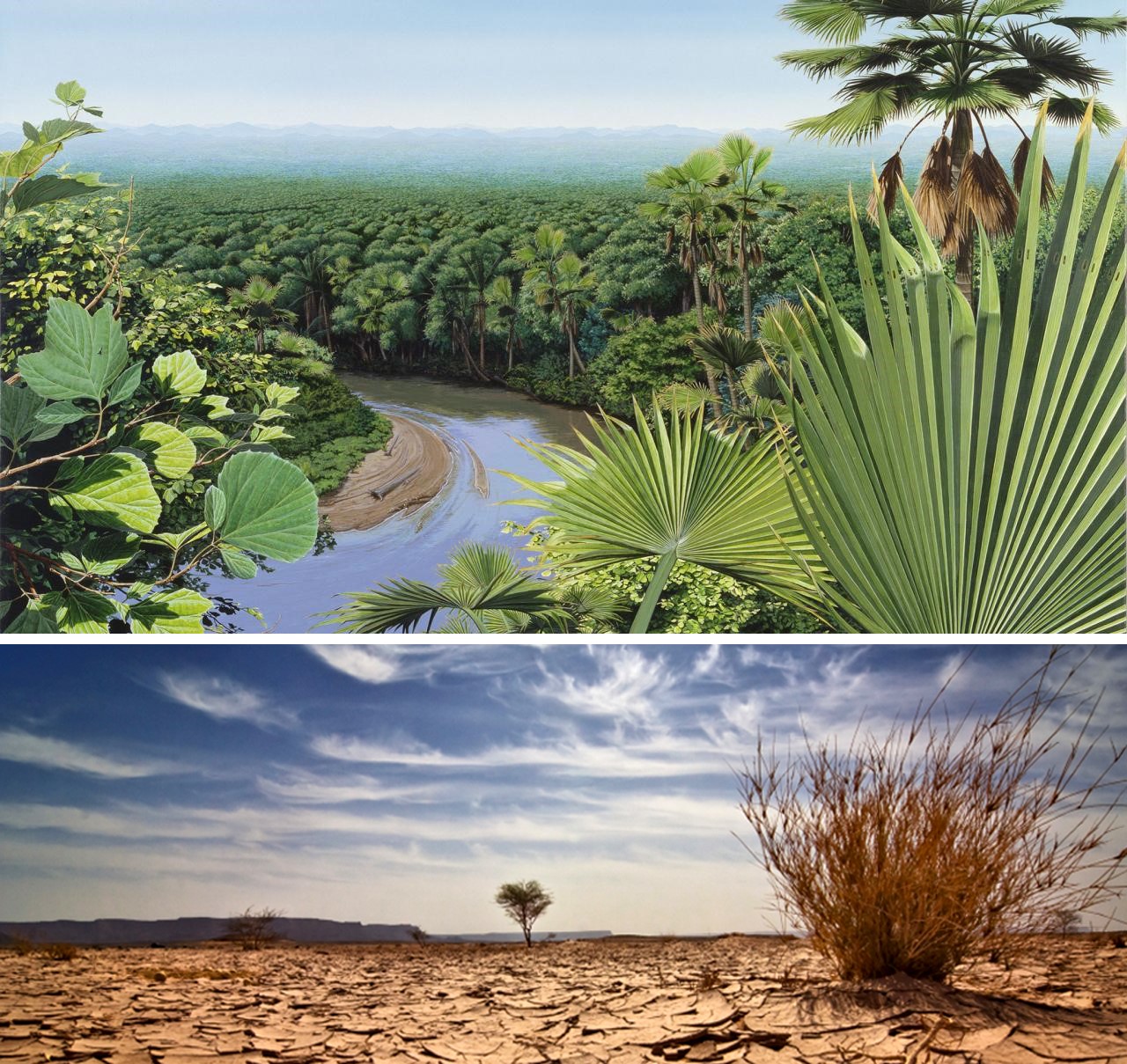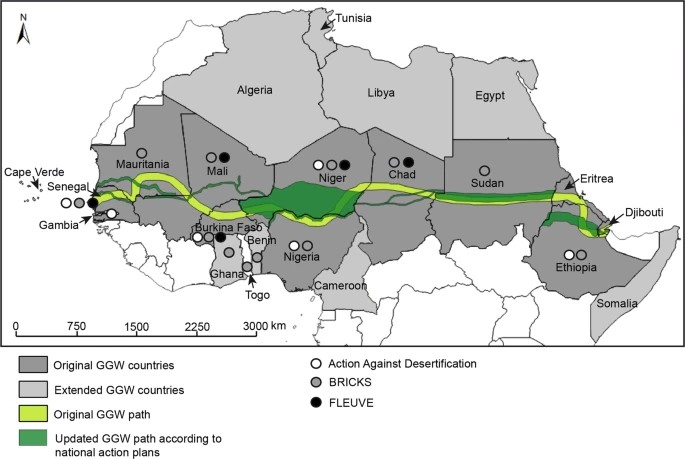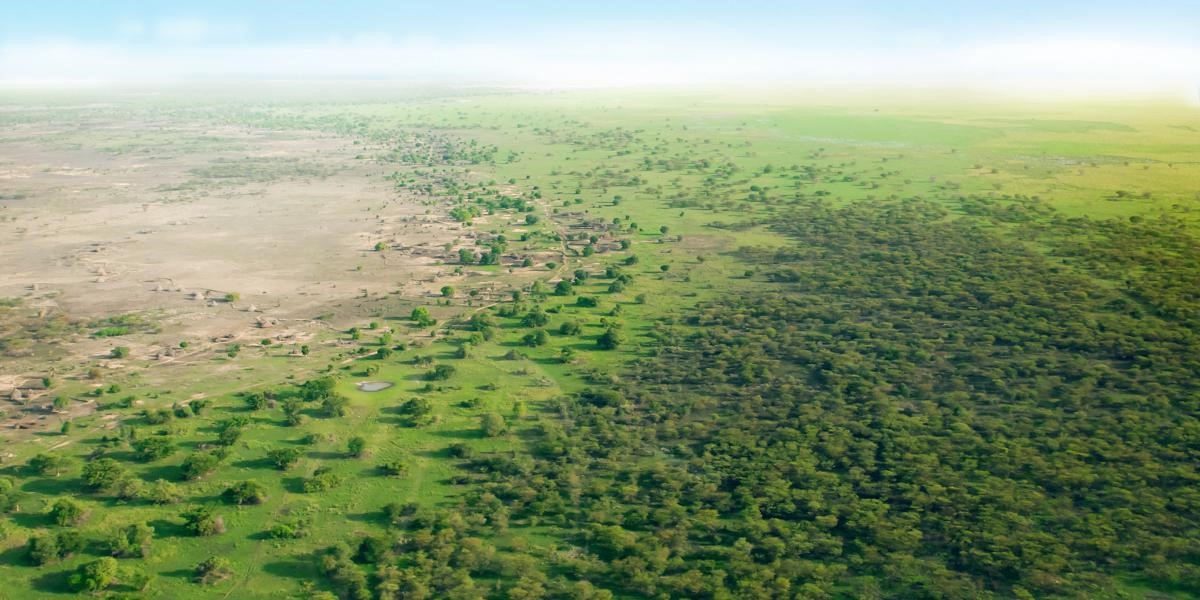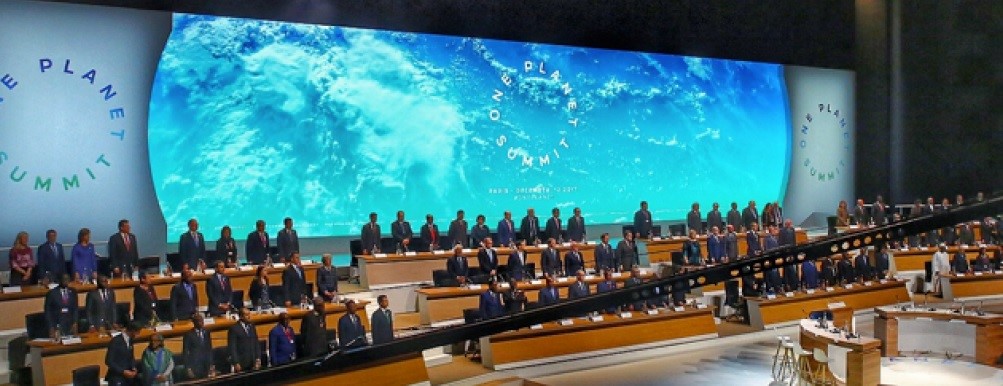
These are images of the same area in southern Libya – as it was in the days when the Roman Empire fought the Carthaginians, and as it is today. Two different and apparently irreconcilable planets. But this is not the case: the Sahel became Sahara (a desert) because the rainforest that covered it was overwhelmed by mankind, which used in a few hundred years all the wood (for buildings and weapons), all the water (for irrigation), all the game (for a growing nomadic population that despised the more evolved tribes that had become sedentary and had dedicated themselves to agriculture). Even today, the Sahara is growing by 10% every century and, if it is not stopped, in two centuries it will also wipe out the cultures and human settlements of the central African coast[1]. For once, at least, mankind is not sitting on its hands and waiting for disaster…
The Sahel has the image of a cursed land: famine, jihadism, tribal wars, coups, trafficking in arms, drugs and human beings, an endless horror, also due to the misery and extreme conditions in which people live in and around the desert. Politically, there are small steps forward, thanks to the growth of a democratic conscience in the younger generations – but the humanitarian crisis shows no sign of slowing down, on the contrary: 135 million people live in the Sahel today[2], a figure that is set to double by 2050 and reach 670 million by the end of the century[3]. A quarter of the inhabitants are dying of hunger and thirst; the number of almost 2 million displaced persons is growing as famine and armed conflict intensify[4]; 176,000 refugees with no future have been living in concentration camps on the edge of the desert for years[5].
All this can change in a surprisingly short time: the FAO (the United Nations agency that deals with agriculture and world hunger) has set in motion a gigantic project, called the Great Green Wall, which aims to restore water, forest and game to the largest desert area on the planet within twenty years, giving it back life and hope, and thus contributing positively to the overall balance of Planet Earth.
Destination Sahel: where the future of the planet is decided

The Sahel area (in orange), which crosses countries plagued by political and climatic instability[6]
The Sahel, once a land of meadows and rainforest, home to vast commercial empires and cultures that were later destroyed in tribal wars, is now a sandy land scattered with rocks, divided (geographically and culturally) between the dry Sahara to the north and the more fertile savannahs to the south. It is 4000 km from Senegal on the Atlantic coast, through Mauritania, Mali, Burkina Faso, Algeria, Libya, Niger, Nigeria, the Central African Republic, Chad and Sudan, to Eritrea, Ethiopia and Somalia on the Red Sea coast.
The problems of the region are dramatically interrelated. Medieval kingdoms have been replaced by European colonial empires, and the end of colonialism has artificially reunited territories inhabited by ethnic groups that have been at war with each other for centuries. The lack of national sentiment prevents the emergence of modern nation states with a strong feeling of identity and belonging among its citizens.
Each individual tribe thinks only of its own today, and the idea of building infrastructure (functional housing, education, economic and productive coordination, health care, aqueducts and canalisation) is not a majority one, but decidedly elitist. As if that were not enough, climate change is worsening living conditions, forcing people to migrate, to mix with other ethnic groups, and encouraging clashes over scarce water sources or pastures.
The mechanisms that accelerate desertification are well known: in addition to the reduction in rainfall, which led to long and dramatic periods of drought such as the one between the 1970s and 1980s[7], and to rising temperatures[8], the direct action of man has contributed decisively to the destruction of the ecosystem. During the colonial era, agriculture and pastoralism were encouraged[9], creating the disappearance of old and consolidated social balances[10] and destroying entire forests to make way for pastures and crops[11].
These crops, mostly industrial monocultures of multinational companies, promote desertification with the enormous consumption of water and the use of chemical compounds that poison the aquifers[12]. The continuous cutting down of trees prevents the creation of new aquifers, and makes the soil unstable in the rainy season[13]. All these things are well known today, but already a century ago they were the focus of the heroic battle of a forerunner, Richard St. Barbe Baker.
The crazy and wonderful dream of Richard St. Barbe Baker

Nairobi, Kenya, 1953: Richard St. Barbe Baker at the end of the first Sahara University expedition[14]
If you think environmentalism is a modern thing, you are wrong: the first environmentalists were already active more than 5000 years ago[15]. One of the earliest rebellions by those who can undoubtedly be likened to modern environmentalists was that of the Bishnoi Hindus of Khejarli, who were massacred by the Maharaja of Jodhpur in 1720 for trying to protect the forest that the Maharaja wanted to cut down to build a palace[16]. In 1739, Benjamin Franklin and other residents of Philadelphia petitioned the Pennsylvania Assembly to stop the dumping of waste and remove the tanneries from the city’s commercial district[17]. From then on, local movements multiplied everywhere.
Scientist Richard St. Barbe Baker, however, is a cut above the rest. At a very young age, he espoused the Bahá’í faith, a monotheistic religion that pays great attention to the balance between man and the environment – a worldview he learned from his family, agricultural scientists ante litteram[18]. He calls trees his friends: his biography tells us that he has personally planted 26 billion trees around the world[19].
Since 1920 he has worked as a forester in the British colonies in Africa and is Assistant Conservator of Forests in Kenya[20]. He realises that devastation is taking place and that the large-scale encouragement of agriculture and pastoralism is having an extremely negative impact on the ecosystem balance: virgin forests are rapidly shrinking in size, which is destroying the soil’s ability to conserve water[21].
The only possible solution is reforestation: at first he only obtained the collaboration of the Kikuyu warriors, and in 1922 he began a reforestation project with them, without regard for British colonial power[22]. It was the beginning of a fascinating personal journey: in 1924 Baker founded the Men of the Trees organisation, which spread to many countries under the name of the International Tree Foundation[23]. It was a project that everyone understood and shared, especially the natives, who were otherwise so reluctant to accept lessons from the white man.
In 1952, Baker led the first expedition of the University of the Sahara, covering some 14,500 km from Algiers to Kilimanjaro, to analyse the advance of the desert and develop strategies to stop its expansion[24]. His first idea remains confirmed: the desert’s advance can only be stopped by creating a ‘green front’ of trees, 6,400 km long and 48 km wide, along the southern foothills of the Sahara[25].
Baker engaged in gruelling diplomatic negotiations with the heads of state of 24 countries throughout his life in search of concrete support for his project. He died in 1982 without having seen the finish line, but without doubt having the merit of having profoundly changed the attitude and awareness of Africans and of having launched local projects using techniques that are still used today. His cyclopean and visionary ‘green front’ project, therefore, does not die with him[26].
The Great Green Wall

The planned development of the Great Green Wall (light green), with corrections made by the individual national governments (dark green) of the project’s founding countries[27]
In Algeria, in the wake of Baker’s experiences, the Green Dam project was launched in the 1970s to mitigate the effects of desertification in the Sahara.[28] The approach is full of goodwill, but also of mistakes, such as evictions for planting or the use of single-species trees, actions that lead to social tensions: the results are not enthusiastic, so the method gradually changes, enriched by increasingly advanced procedures, such as the use of different species of trees to adapt to the geography of the place and more careful social and political planning[29].
In 1978, China decided to stop the expansion of the Gobi Desert – a quadrangle more than 4000 km long by almost 1000 km wide. The project, called the Three North Shelter Forest Program[30], was renamed the ‘Great Green Wall’ by then-President Deng Xiaoping: it is an integrated agricultural, pastoral and forestry system that also takes into careful consideration social development and the creation of infrastructure – an ambitious plan, to be completed by 2050, which, despite some mistakes along the way, must still be considered a success[31].
This is where the FAO gets the idea of reforesting Africa. It was first discussed (officially) during the 7th Summit of the Community of Sahel-Saharan States (CEN-SAD) on 1 and 2 June 2005 in Ouagadougou (Burkina Faso). The then President of Nigeria, Chief Olusegun Obasanjo, supported by Senegalese President Abdoulaye Wade, decided to initiate a project called “Great Green Wall for the Sahel and Sahara Initiative” (GGWSSI), which was then presented at the 5th Ordinary Summit of the African Union in July 2005 in Sirte, Libya[32].
The idea of stemming desertification by means of land reclamation and redevelopment is not only to plant new trees, but also to integrate individual local projects with measures to make uninhabited areas habitable again, revitalising the use of soil, water and forest resources, pastoral development, agricultural production and gender integration in development[33]. The initiative was applauded by the various governments of Djibouti, Eritrea, Ethiopia, Mali, Mauritania, Burkina Faso, Niger, Senegal, Sudan and Chad, which, together with Nigeria, initiated the development of local actions: in June 2006, at a new CEN-SAD summit, a commission of specialists was set up to coordinate a detailed environmental monitoring[34].
The project quickly took shape. In January 2007, with Declaration 137/VIII[35], the African Union officially launched the implementation of the Great Green Wall, which, with the 11 countries already active since the CEN-SAD summit, provides for rapid implementation of the original project, which has been extended to include 21 countries[36] and numerous international partners[37].
Learning from mistakes to start again

The involvement of local communities in the Great Green Wall project is crucial to its success[38]
The project is a big step forward for environmentalism: the desert is no longer a ‘disease’, but an ecosystem that contributes to the Earth’s biodiversity and richness. Its expansion depends on human action and climatic variations, not on a destructive soul. Planting should not be generalised, but done in areas where agriculture and pastoralism are advanced and the heritage of organised social nuclei: only then are the benefits immediate and involve the local population.
The regeneration process is a delicate one, because it is not possible to deal with the biological aspects of it apart from the social ones. In simple terms: the project, no matter how mammoth, only works if the inhabitants of each village can be convinced of its usefulness – a consideration that directly influences the choice of plants to be planted[39]. The challenge is not only won by planting new trees, but also by preserving the flora and fauna that already exist and are adapted to each individual location[40].
The failures of the past, which saw hectares of new trees destroyed because the project was not integrated with the socio-economic variations of local realities, must not be repeated[41]. With an agreement between the Heads of State and Government of Burkina Faso, Djibouti, Eritrea, Ethiopia, Mali, Mauritania, Niger, Nigeria, Senegal, Sudan and Chad, and under the aegis of the African Union, the Pan-African Agency of the Great Green Wall (PAGGW) was created on 17 June 2010[42]. Its mission is to sum up past experiences, make a synthesis of them, elaborate new responses and find the money to implement them[43].
In 2012, the UN Conference on Sustainable Development put the green economy on the global agenda. It discusses how to mitigate climate impacts while protecting biodiversity, and how to ensure food security for the population[44]. The Great Green Wall project becomes a strategic hub of the UN and FAO, international funds are released, and work is done on its implementation with other international projects[45] such as the United Nations Convention to Combat Desertification (UNCCD), the World Bank (WB), the Global Environment Facility (GEF) and the International Union for Conservation of Nature (IUCN)[46].
In 2014, the UN launched the Action Against Desertification programme, an initiative of the African, Caribbean and Pacific (ACP) Group of States, which aims to reclaim arid and degraded lands in Africa, the Caribbean and the Pacific, and will be a key partner for the Great Green Wall[47]. The programme has been operational since 2016: FAO, together with the Africa Union Commission, the European Union, the Organisation of African, Caribbean and Pacific States, the United Nations Convention to Combat Desertification and others, will allocate a budget of €41 million for the first environmental restoration plan[48].
Good but not great – in fact bad

The completed part of the Great Green Wall, Ethiopia[49]
Much has been achieved since then, but what the ambitious targets promised – restoring 100 million hectares of degraded land, removing 250 million tonnes of CO2 and creating 10 million jobs in rural areas by 2030[50] – has not happened.
In 2020, half of the time planned for the project has passed, but only a disappointing 4% has been achieved[51]. 18 million hectares of land have been made fertile, 350,000 new jobs have been created and some USD 90 million in revenue has been generated[52]. But this compares with more than 200 million dollars invested and, therefore, massive losses[53]. There are huge differences between the works carried out by individual states – dependent, of course, on the war, social and political situation in the individual country. Ethiopia began reforestation earlier than other countries in the region, and is in the forefront, having planted 5.5 billion trees on 151,000 hectares of new forest and 792,000 hectares of new fields[54]. Burkina Faso, on the other hand, has planted only 16.6 million trees; Chad 1.1 million, although the two countries have received the most financial support[55].
The economic aspect is central: it is estimated that the average cost of environmental restoration in Africa is USD 440 per hectare, but for the most suffering regions of the Sahel this figure rises to USD 530[56]. This means that between 36 and 43 billion dollars will be needed to go ahead until 2030 – but so far the project has only been funded to the tune of 206 million dollars, which is totally insufficient to achieve the objectives set[57].
Salwa Bahbah, a research analyst at Climatekos, the company in charge of drafting the UN report, says: “We don’t know exactly where the money goes and how it is used”[58]. The World Bank’s 2020 report states that the countries that receive the most international aid are also those whose politicians have the most bank deposits in tax havens[59].
It is a fact that states in the Sahel region are among the most corrupt in the world. In addition, the Sahel is teeming with insurgent groups and Islamic rebels, warring ethnic groups and international criminal groups in constant search of new economic resources, now intertwined with local political and commercial activities[60]. The extent to which these elements have influenced the slowing down of the GGW project to date is difficult to determine, but that they have contributed is quite possible.
The Great Green Wall Accelerator

The One Planet Summit for Biodiversity[61]
International organisations realise that the project is in danger of sinking and try to regroup. During the One Planet Summit for Biodiversity on 11 January 2021, organised by France, the United Nations and the World Bank[62], the Great Green Wall Accelerator is presented, an initiative that aims to improve collaboration between global agencies, national authorities, local communities and the private sector. Coordination is assigned to PAAGGW and, this time, it is endowed with a budget of USD 14.326 billion[63].
President Mohamed Cheikh Oud Ghazouani of Mauritania, head of PAAGGW, enthusiastically announces: “This additional funding, together with a new operational approach, will contribute to the safe achievement of the Great Green Wall objectives”[64]. At the same time, private foundations, such as the Bill & Melinda Gates Foundation and the Rockefeller Foundation, formed the AGRA (Alliance for a Green Revolution in Africa), have also decided to contribute to individual local projects coordinated by FAO and PAAGW[65].
But the project’s enemies have prepared to sabotage everything: the agricultural multinationals Monsanto and Yara have launched a press campaign in all African countries, insinuating that behind the idea of the Great Green Wall there are commercial interests that are anything but transparent[66], and meanwhile, in a veiled manner, they repeat that the multinationals have global control of the seed market anyway[67].
There is an immensely important game at stake: who will acquire control and ownership of the land reclaimed and transformed from desert into farmland – this land acquires great commercial value and is taken away from the farmers by violence, deception and abuse: it is not enough to turn sand into a garden, it must be able to defend it, and this detail is not (unfortunately) part of the FAO and UN project, and the national states involved do not have the strength to guarantee anything.
It is very worrying that public opinion is not aware of this, the greatest project for the resurrection of the planet. As if it did not happen or did not interest anyone – or there is not, not even in the West, a political majority in favour of saving the Sahara (and, therefore, mitigating the summers in the Mediterranean area, which in recent years have become intolerable. The Great Green Wall Accelerator promises to address this as well. Past mistakes have hopefully taught us something. Romanticism aside, we can only agree.
[1] https://e360.yale.edu/digest/the-sahara-desert-has-grown-10-percent-since-1920 ; https://journals.ametsoc.org/view/journals/clim/31/9/jcli-d-17-0187.1.xml?tab_body=fulltext-display
[2] https://www.prb.org/resources/demographic-challenges-of-the-sahel/
[3] https://www.prb.org/resources/demographic-challenges-of-the-sahel/
[4] https://www.voanews.com/africa/internal-displacement-sahel-tops-2-million-armed-conflict-intensifies
[5] https://dtm.iom.int/reports/west-and-central-africa-%E2%80%94-liptako-gourma-crisis-monthly-dashboard-14-25-february-2021
[6] https://thearabweekly.com/sahel-struggles-terror-poverty-and-climate-change
[7] https://news.globallandscapesforum.org/40544/as-the-sahel-dries-the-sahara-advances/
[8] https://www.oecd-ilibrary.org/docserver/5jlsmktwjcd0-en.pdf?expires=1624789394&id=id&accname=guest&checksum=4A7FDADF80192BD6650AB6F6E407F1BC “Climate Impacts in the Sahel and West Africa: The role of climate science in policy making” – West African Papers No. 02
[9] https://agritrop.cirad.fr/580714/7/Gautier_2016_Impacts_drought_responses_rural_populations_West_Africa.pdf “Impacts of drought and responses of rural populations in West Africa” – Denis Gautier, David Denis, Bruno Locatelli – 2016
[10] https://agritrop.cirad.fr/580714/7/Gautier_2016_Impacts_drought_responses_rural_populations_West_Africa.pdf “Impacts of drought and responses of rural populations in West Africa” – Denis Gautier, David Denis, Bruno Locatelli – 2016
[11] https://core.ac.uk/download/pdf/48835717.pdf “Environmental Impacts of Colonialism” – Lawrence Wood – 12/14/2015
[12] https://pubs.iied.org/sites/default/files/pdfs/migrate/9027IIED.pdf “Science, Use Rights and Exclusion: A History of Forestry In Francophone West Africa” – Jesse Ribot – 2002; https://e360.yale.edu/features/how-africas-big-water-projects-helped-trigger-the-migrant-crisis
[13] https://agupubs.onlinelibrary.wiley.com/doi/full/10.1002/2013WR015197 ; https://onlinelibrary.wiley.com/doi/full/10.1002/ldr.3430 ; https://www.cifor.org/knowledge/publication/5996/
[14] https://bahaiteachings.org/the-man-of-the-trees-and-the-great-green-wall/
[15] https://www.greenpeace.org/international/story/11658/a-brief-history-of-environmentalism/
[16] https://www.greenpeace.org/international/story/11658/a-brief-history-of-environmentalism/
[17] https://www.newworldencyclopedia.org/entry/Environmentalism
[18] https://iefworld.org/cmpquotes.htm
[19] https://stbarbebaker.wordpress.com/2016/06/08/st-barbe-tributes/
[20] https://library.usask.ca/archives/campus-history/ocn/ocn_1dec1995-trees.php
[21] https://news.bahai.org/story/1292/
[22] https://news.bahai.org/story/1292/
[23] https://internationaltreefoundation.org/
[24] https://www.wildernessfoundation.co.za/news/st-barbe-and-the-incredible-journey
[25] https://www.wildernessfoundation.co.za/news/st-barbe-and-the-incredible-journey
[26] https://stbarbebaker.wordpress.com/2016/06/08/st-barbe-tributes/
[27] https://link.springer.com/article/10.1007/s10113-019-01481-z
[28] https://www.researchgate.net/publication/273286423_The_Green_Dam_in_Algeria_as_a_tool_to_combat_desertification ; https://www.ipcc.ch/srccl/chapter/chapter-3/ par. 3.7.2.2
[29] https://agritrop.cirad.fr/567880/1/document_567880.pdf “The African Great
Green Wall project” – R. Bellefontaine, M. Bernoux and other – I. Amsallem, Agropolis Productions, S. Jauffret, Ecological Consultant – Page 6 ; https://www.ipcc.ch/srccl/chapter/chapter-3/
[30] https://www.researchgate.net/figure/The-Three-North-Shelter-Forest-Program-TNRSF-in-northern-China-defined-also-by-green_fig1_303853110
[31] https://ecobnb.com/blog/2019/07/china-the-new-green-wall-which-will-stop-the-desert-advancing/
[32] http://www.grandemurailleverte.org/images/ENG_GGWI_ACHIEVEMENT-2011_2017.pdf
[33] https://africa-eu-partnership.org/sites/default/files/documents/090723_actionplan_ggwss_censad_ua_may08.pdf
[34] http://sdg.iisd.org/news/sahel-saharan-states-to-set-up-research-commissions/
[35] https://oau-aec-au-documents.uwazi.io/en/document/zbktxmf46v6t2miuv94cmcxr?page=2
[36] https://www.greatgreenwall.org/partners
[37] http://www.streetstore.it/templates/layout_1/index_1.php?callpage=cls&cls=654
[38] https://www.unep.org/news-and-stories/story/good-news-africas-great-green-wall
[39] https://www.smithsonianmag.com/science-nature/great-green-wall-stop-desertification-not-so-much-180960171/
[40] https://www.iied.org/sahelian-great-green-wall-start-local-solutions
[41] https://agritrop.cirad.fr/567880/1/document_567880.pdf
[42] https://www.iucn.org/theme/ecosystem-management/our-work/global-drylands-initiative/gdi-projects/closing-gaps-great-green-wall-linking-sectors-and-stakeholders-increased-synergy-and-scaling
[43] https://web.archive.org/web/20130810082842/http://www.grandemurailleverte.org/gmv/donnees/Convention%20MIRAILLE%20EN%20ANGLAIS.pdf
[44] https://www.minambiente.it/pagina/conferenza-rio20-una-sfida-importante
[45] https://www.unccd.int/news-events/united-nations-releases-rio-plus-20-zero-draft-future-we-want ; https://wedocs.unep.org/bitstream/handle/20.500.11822/26095/AMCEN14_decisions.pdf?sequence=1&isAllowed=y
[46] https://catalogue.unccd.int/1551_GGW_Report_ENG_Final_040920.pdf
[47] http://www.fao.org/in-action/action-against-desertification/overview/en/
[48] https://knowledge.unccd.int/sites/default/files/inline-files/Biblio_Great_Green_Wall_research_Success_stories_news_science_media_projects.pdf
[49] https://www.unccd.int/news-events/great-green-wall-one-planet-summit-2021
[50] https://www.greatgreenwall.org/2030ambition
[51] https://www.theguardian.com/environment/2020/sep/07/africa-great-green-wall-just-4-complete-over-halfway-through-schedule
[52] https://catalogue.unccd.int/1551_GGW_Report_ENG_Final_040920.pdf
[53] https://catalogue.unccd.int/1551_GGW_Report_ENG_Final_040920.pdf
[54] https://www.theguardian.com/environment/2020/sep/07/africa-great-green-wall-just-4-complete-over-halfway-through-schedule
[55] https://www.theguardian.com/environment/2020/sep/07/africa-great-green-wall-just-4-complete-over-halfway-through-schedule
[56] https://catalogue.unccd.int/1551_GGW_Report_ENG_Final_040920.pdf
[57] https://catalogue.unccd.int/1551_GGW_Report_ENG_Final_040920.pdf
[58] https://www.theguardian.com/environment/2020/sep/07/africa-great-green-wall-just-4-complete-over-halfway-through-schedule
[59] https://documents.worldbank.org/en/publication/documents-reports/documentdetail/493201582052636710/elite-capture-of-foreign-aid-evidence-from-offshore-bank-accounts ; https://documents1.worldbank.org/curated/en/493201582052636710/pdf/Elite-Capture-of-Foreign-Aid-Evidence-from-Offshore-Bank-Accounts.pdf
[60] https://www.gtreview.com/magazine/volume-19-issue-2/great-green-wall-project-wall-worth-building/
[61] https://www.genesisarg.com/en/novedades/cumbre-one-planet-nuevos-compromisos-de-financiacion-dan-un-gran-impulso-al-acuerdo-de-paris/
[62] https://www.unccd.int/news-events/one-planet-summit-biodiversity
[63] https://www.greatgreenwall.org/great-green-wall-accelerator
[64] https://greenreport.it/news/aree-protette-e-biodiversita/one-planet-summit-impegni-concreti-per-proteggere-la-biodiversita-e-per-realizzare-aree-protette-a-mare-e-a-terra-e-ce-anche-litalia/
[65] https://allafrica.com/stories/202004080119.html
[66] https://leadersinwildlifeconservation.org/blogs/f/the-great-green-wall-in-africa?blogcategory=Threats
[67] https://www.dw.com/en/agriculture-seeds-seed-laws-agribusinesses-climate-change-food-security-seed-sovereignty-bayer/a-57118595
Leave a Reply